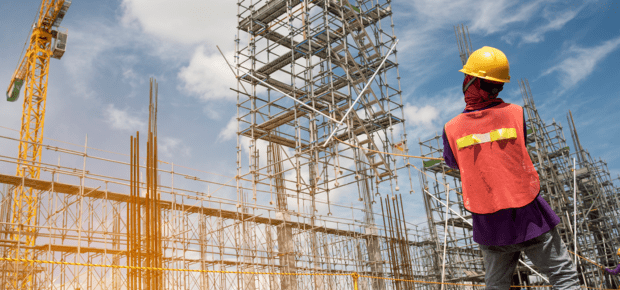September 9, 2019
Risk of injury comes with the territory for those working on construction sites. But that doesn’t mean that steps can’t be taken to eliminate physical hazards and risky practices to save lives and mitigate the potential for catastrophe.
IEEE Member Qi Dong is an expert in emerging technologies including Artificial Intelligence (AI), machine learning, and the Internet of Things (IoT) and how they can support safety on construction sites, while also improving transparency and accountability in the supply chain.
Smart Construction Sites
Dong highlights one of the United States Occupational Safety and Health Administration’s (OSHA) “Fatal Four” — the potential to be struck by a falling object — which caused nearly 60 percent of construction worker deaths in 2017.
“The Ministry of Housing and Urban-Rural Construction of China, like OSHA, found being struck by a falling object to be a leading cause of fatalities on construction sites,” says Dong. “This problem could be reduced by more strictly adhering to proper safety protocols.”
In order to address this problem directly, Dong highlighted a unique way that 4G/5G and AI are being leveraged in tandem to reduce risk, which he hopes will see wider adoption in the future.
“When construction workers do not wear hardhats or helmets on site, it is, extremely dangerous,” says Dong “Luckily, advancements in AI, coupled with 4G/5G, are enabling supervisors to monitor their workers from afar, knowing when they are and aren’t wearing protective gear on site. So, when worksites are fashioned with sensors and other IoT devices, workers can be monitored in real-time.”
Emerging technologies can also support improved safety on worksites by providing the ability to proactively avoid hazards before they pose a serious threat to on-the-ground workers. Instead of addressing the problems caused by exposed wires, for example, after they’ve been stumbled upon and caused damage, many lives can be saved because technologies that enable their detection in advance.
Additionally, in the initial planning stages of a project, architects and engineers can leverage emerging technologies to better identify potential challenges, leading to worksites purposefully designed to support safety.
Infrastructure Monitoring
Danger isn’t necessarily removed once a project is complete; construction workers are often tasked with structural upkeep and large-scale modernization projects, which aren’t without risk.
“Historically, data on the status of a building and its structure had to be sourced by human monitoring, putting the lives of workers at risk,” adds Dong. Anytime a worker has to step foot on a site they’re at risk, of course. Now, with cloud-based technologies and IoT devices rising in prominence, engineers are able to monitor the integrity of structures remotely and more efficiently.”
In addition to the safety emerging technologies immediately provide, they also enable engineers to better monitor structural integrity and disrepair over longer periods of time, empowering workers to engage in upkeep at the optimum time in the infrastructure lifecycle. This helps minimize concern about working on a deteriorating site with undetected and unpredictable structural issues that could lead to injury.
These benefits also extend to infrastructure modernization, for which many workers are continuously tapped.
The Supply Chain
Beyond the ability to improve safety on site, emerging technologies also provide improved visibility into the supply chain at various stages, which, according to Dong, is very important in terms of optimization, particularly on large-scale projects with many moving parts.
“Take concrete, for example. Trucks utilized for the delivery of concrete are often leased, so if all of them are equipped with 4G/5G communication modules, a construction company would have improved visibility into the supply chain process, better understanding how much concrete would arrive with each shipment, when each shipment would arrive by, and more,” Dong explains.
Such technologies lead to improved workforce planning and cost-efficiencies that enable construction companies and vendors to save money that may be allocated elsewhere.
Safety Standards
According to Dong, technical standards developed by IEEE are being utilized to promote safety in construction, particularly in regard to emerging technologies that are increasingly being deployed on worksites around the world.
“Increasingly we’re seeing unmanned aerial vehicles (UAVs), WiFi-supported handheld devices, IoT-backed sensors, and other emerging technologies deployed in the construction industry. Whether in the supply chain or on actual worksites, IEEE’s standards are supporting the safe application of these technologies, which are poised to play a major role in the construction industry moving forward.”
IEEE is committed to developing global standards in a broad range of industries to ensure the safe and ethical utilization of technology for the benefit of humanity; the organization has helped develop standards for over a century, many of which have heavily influenced the day-to-day life of individuals around the world.
Read more about how IEEE Standards are making construction practices safer and smarter here:
IEEE 1654-2009 – IEEE Guide for RF Protection of Personnel Working in the Vicinity of Wireless Communications Antennas Attached to Electric Power Line Structures
IEEE P1814 – IEEE Draft Recommended Practice for Electrical System Design Techniques to Improve Electrical Safety
IEEE P2048.5 – Standard for Virtual Reality and Augmented Reality: Environment Safety
IEEE P2821 – Guide for Unmanned Aerial Vehicle-based Patrol Inspection System for Transmission Lines
IEEE P3007.3 – Recommended Practice for Electrical Safety in Industrial and Commercial Power Systems







 Meaningful Momentum or Running in Place?
Meaningful Momentum or Running in Place? AI Through Our Ages
AI Through Our Ages Liquid Infrastructure: Our Planet's Most Precious Resource
Liquid Infrastructure: Our Planet's Most Precious Resource The Impact of Technology in 2025
The Impact of Technology in 2025 Quantum and AI: Safeguards or Threats to Cybersecurity?
Quantum and AI: Safeguards or Threats to Cybersecurity? Why AI Can't Live Without Us
Why AI Can't Live Without Us Bits, Bytes, Buildings and Bridges: Digital-Driven Infrastructure
Bits, Bytes, Buildings and Bridges: Digital-Driven Infrastructure Impact of Technology in 2024
Impact of Technology in 2024 Emerging AI Cybersecurity Challenges and Solutions
Emerging AI Cybersecurity Challenges and Solutions The Skies are Unlimited
The Skies are Unlimited Smart Cities 2030: How Tech is Reshaping Urbanscapes
Smart Cities 2030: How Tech is Reshaping Urbanscapes Impact of Technology 2023
Impact of Technology 2023 Cybersecurity for Life-Changing Innovations
Cybersecurity for Life-Changing Innovations Smarter Wearables Healthier Life
Smarter Wearables Healthier Life Infrastructure In Motion
Infrastructure In Motion The Impact of Tech in 2022 and Beyond
The Impact of Tech in 2022 and Beyond Cybersecurity, Technology and Protecting Our World
Cybersecurity, Technology and Protecting Our World How Technology Helps us Understand Our Health and Wellness
How Technology Helps us Understand Our Health and Wellness The Resilience of Humanity
The Resilience of Humanity Harnessing and Sustaining our Natural Resources
Harnessing and Sustaining our Natural Resources Creating Healthy Spaces Through Technology
Creating Healthy Spaces Through Technology Exceptional Infrastructure Challenges, Technology and Humanity
Exceptional Infrastructure Challenges, Technology and Humanity The Global Impact of IEEE's 802 Standards
The Global Impact of IEEE's 802 Standards Scenes of our Cyber Lives: The Security Threats and Technology Solutions Protecting Us
Scenes of our Cyber Lives: The Security Threats and Technology Solutions Protecting Us How Millennial Parents are Embracing Health and Wellness Technologies for Their Generation Alpha Kids
How Millennial Parents are Embracing Health and Wellness Technologies for Their Generation Alpha Kids Space Exploration, Technology and Our Lives
Space Exploration, Technology and Our Lives Global Innovation and the Environment
Global Innovation and the Environment How Technology, Privacy and Security are Changing Each Other (And Us)
How Technology, Privacy and Security are Changing Each Other (And Us) Find us in booth 31506, LVCC South Hall 3 and experience the Technology Moon Walk
Find us in booth 31506, LVCC South Hall 3 and experience the Technology Moon Walk Virtual and Mixed Reality
Virtual and Mixed Reality How Robots are Improving our Health
How Robots are Improving our Health IEEE Experts and the Robots They are Teaching
IEEE Experts and the Robots They are Teaching See how millennial parents around the world see AI impacting the lives of their tech-infused offspring
See how millennial parents around the world see AI impacting the lives of their tech-infused offspring Take the journey from farm to table and learn how IoT will help us reach the rising demand for food production
Take the journey from farm to table and learn how IoT will help us reach the rising demand for food production Watch technical experts discuss the latest cyber threats
Watch technical experts discuss the latest cyber threats Explore how researchers, teachers, explorers, healthcare and medical professionals use immersive technologies
Explore how researchers, teachers, explorers, healthcare and medical professionals use immersive technologies Follow the timeline to see how Generation AI will be impacted by technology
Follow the timeline to see how Generation AI will be impacted by technology Learn how your IoT data can be used by experiencing a day in a connected life
Learn how your IoT data can be used by experiencing a day in a connected life Listen to technical experts discuss the biggest security threats today
Listen to technical experts discuss the biggest security threats today See how tech has influenced and evolved with the Games
See how tech has influenced and evolved with the Games Enter our virtual home to explore the IoT (Internet of Things) technologies
Enter our virtual home to explore the IoT (Internet of Things) technologies Explore an interactive map showcasing exciting innovations in robotics
Explore an interactive map showcasing exciting innovations in robotics Interactively explore A.I. in recent Hollywood movies
Interactively explore A.I. in recent Hollywood movies Get immersed in technologies that will improve patients' lives
Get immersed in technologies that will improve patients' lives